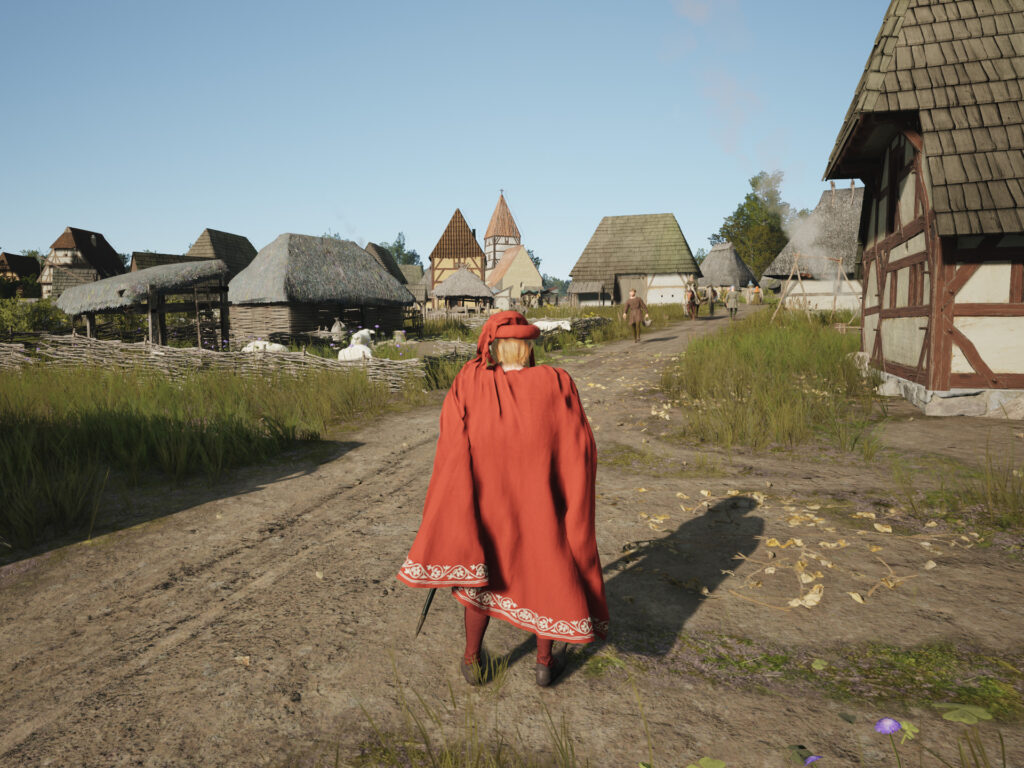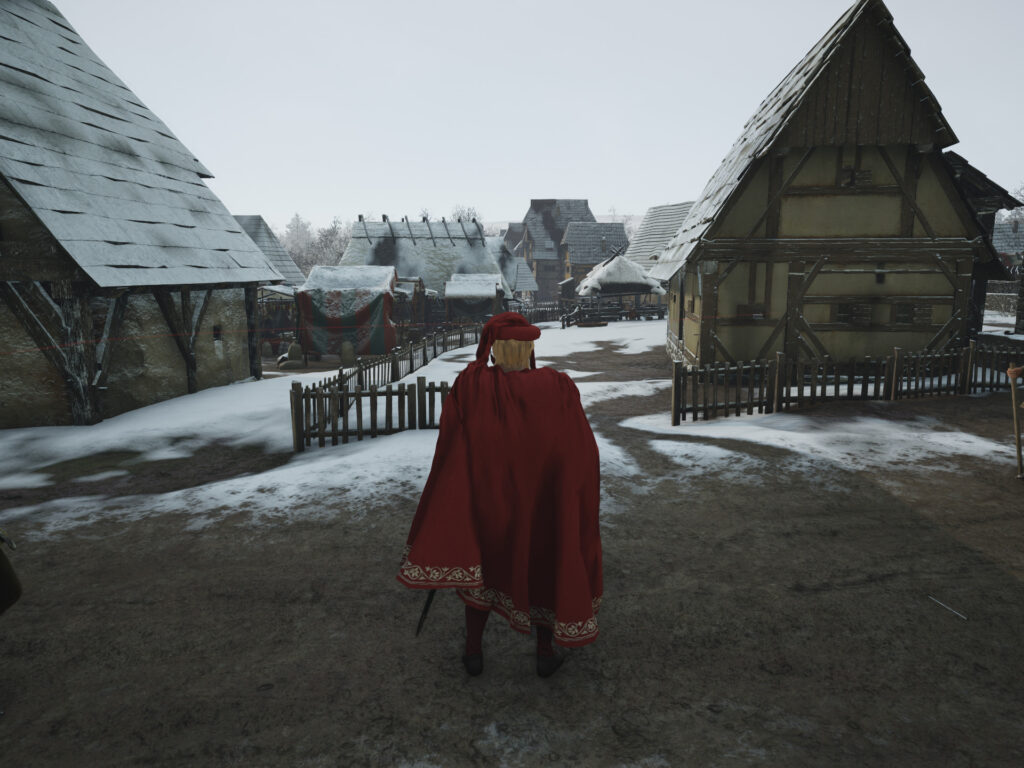Manor Lords was released to early access on Steam yesterday to much fanfare; I heard about it from so many places, it’s hard to believe it is a single developer, indie game. Someone’s marketing budget was on point.
At its heart, “Manor Lords” is the latest entry in the medieval village building genre that includes “Banished”, “Life is Feudal: Forest Village”, “Anno 1404” and so on. To this city building heart is grafted a conquest component where you, as the titular Manor Lord, strike up your levies, pay some mercenaries, protect your home from bandit raids and make common cause or conquest with your neighbors.
But the nicest addition, to me, is a Victory Condition! I really dislike sandboxes that go on forever because it’s hard for me to find an off ramp. I was overjoyed when, about ten hours in on the pacifist mode, I leveled my kingdom into a Large Town and the game played a short cutscene, and then ended.
The pacifist run is just one way to play the game; you can also play the game with neighboring territories that will not bother you until you bother them, and neighboring territories that will come at you as soon as they are able. Additionally, you are able to tune the number of bandit raids (from none to day 1: prepare for battle) to your liking, as well as generally setting the difficulty.
The game has an ending, but you can play it again differently.
Manor Lords doesn’t know anything about “workers”. This is probably its greatest innovation over the games that have come before in this genre. The unit of effort here is “families”. Families open up businesses, go work on farms, decide to become brewers and whatnot. Each family can contain three or four members, depending on how happy they are and how much food is available. New families move in; sometimes they come across your territory organically, sometimes they come because one of the families that already live in your town tell them how much fun they’re having.
However they arrive, they won’t come at all unless they have someplace to live. This wasn’t something I understood, right away. I thought they would show up, and then I would have to build homes for them to live in. Not so. If you build homes, someone will move in (if your approval rating is high enough, anyway).
Unlike those games that have you zone areas for residential, commercial and so on, in this one, you’re able to decide upon the plots upon which families will build their homes. They can be small and tightly packed with their neighbors, or they can have plenty of room for chicken coops and vegetable gardens or home businesses like brewing or tailoring, making goods for the use of your villagers or trading to others.
Towns can manage by themselves, but to thrive — and to prepare for war — you’ll need to set up trading routes with your neighbors.
Like every other activity in the game, you will need some unassigned families to construct the trading post, and then one or more families to take up the role of trading and set up orders for commodities, resources, and items you need, and accept requests for the same that your village produces for export. Families can be unassigned from a building and assigned to another one at any time, unless they have decided to turn their home into a brewery or a cobbler or some other home-based business, in which case, from that moment on, that is all they do.
If you try to sell too many of an item at once, the price will crash. If you try to buy too many of an item at once, the price will rise. Trade with the surrounding regions is something that requires some care, but once you have it set up, it only really requires the occasional peek unless you have been too greedy or needy, in which case you might find yourself draining the communal wealth pool.
Money isn’t used among villagers, who live communally. But trading requires using communal wealth. Wealth is earned through trading, or by upgrading the villager homes. Base level homes don’t generate wealth, but higher level homes generate wealth appropriate to their level. So by just running the village, you will earn some money. Generate something the surrounding communities need, and you will earn a lot of money.
When your buildings are producing items, some family members will be dispatched to construct a stall in a local market and trade their surplus to other villagers. The market is central to the life of the village; upgrading homes requires a certain availability of items at the market, and upgrading homes is central to upgrading the town.
This generates a specific kind of game loop. A certain neighborhood desires a tavern before they will feel comfortable upgrading their homes. Well, taverns require ale. Ale requires one or more families having had become brewers. Brewers need barley in order to brew, so they need a farm to grow barley. Farms need a farmhouse and farmers, so you need to make more homes in order to lure more people to your village to farm the land.
Building homes requires timber, so you need a logging camp in the vicinity of trees to make timber. Timber needs to be stored in storehouses (all of these require families), and construction requires a family to bring their ox around to drag the timber to the construction site — as well as unassigned families to do the construction. Overlogging will clear cut forests, which starves you of timber, so you need a forester family to replant. More homes for them. (You can trade for a lot of stuff if you have the wealth, but, significantly, not timber. Managing the land is important from day 1.)
When you finally have everyone doing the job and living their best life, you’ll probably have leveled up your village a bit. Now comes the tech tree.
The tech tree changes the entire character of your village; in most games, you can dabble around in various things in the tech tree. You can do that in Manor Lords, nothing is going to stop you. But if you want to be a farming village, the upgrades will double your yield and your farming speed. If you want to prepare for war, you’ll be able to go down that tree. Upping production for your village, or focusing on becoming a trading hub.
In the game, you can conquer and settle other territories. That feature wasn’t available in my pacifist run, but (I imagine) different villages can focus on different capabilities via the tech tree, and there is a mechanism in the game that allows you to use mules to shift large numbers of resources from one of your towns to another. I’m pretty excited to see what that looks like.
The world proceeds through through the seasons as you play, and as the seasons turn, you have to concern yourself with sending people to farms to plant or reap in the spring or fall. Foraging doesn’t happen in the winter. The hunter can overhunt forests, making the local wildlife extinct (you can prevent this). Clear cutting forests will also drive away game, and as your village expands, just the people walking around on paths of desire will tend to prevent forest from growing. Foresters can help with this.
Manor Lords is all about balance; bringing in and exporting trade goods. Having your villagers produce items for barter in the marketplace. In the game modes with combat, levying an army and hiring mercenaries to protect the town and conquering new territory. It’s a game with a lot of moving parts, but in the game I played, issues can generally be dealt with before they cause any real damage. By the end of the game, I had hundreds of villagers and I didn’t need to do anything at all to keep things going.
Oh yeah, crop rotation is a thing. A map overlay lets you know where certain crops will grow best, but even the best performing fields will lose their performance over time. You can rotate crops, leave them fallow for a time, or have your sheep and goats use them as pasture in off years.
Livestock is a whole separate mechanism that I won’t get into.
I want to talk about bread. Bread is the best food. Here’s how you make it.
You will need: a field for growing emmer wheat. A farmhouse for working the field and threshing the wheat into grain (farmhouses can fit eight families). A windmill for grinding the grain into flour (I think two families can be here). A granary to store the flour (with a family or two). A communal oven (with a couple of families) to bake it into bread and bring it to market. Granary workers will come by and bring extra loaves to the granary, and they may have their own stands.
It takes a really long time to get bread going, but when you do, your food worries are over. Or are they?
You need a variety of food. A single food, like bread, won’t do the trick. You can forage berries or, later, herbs. Hunter can bring meat, villagers can grow veggies or get eggs from hens, and you can import other foods.
It’s just… a million things. But, to the game’s credit, these complexities come at a slow enough pace that you can adapt to them.
You start by building a logging hut. Start some homes. Everything flows from that. The game will let you know when you need a storehouse, or if you need more food variety. And suddenly, your village is taking shape.
So yeah. I like the game. I would like to play one of the non-pacifist modes, but it is just in early access as of yesterday, so I think I will wait for a couple of patches before I dive in again, just to see what has changed.










Obligatory “It’s available on PC Game Pass” comment!
I didn’t know that! Well, not until Stargrace mentioned it this morning on Mastodon. I’m still part of the Steam Army and the PlayStation Platoon. I’ve never felt I could afford yet another gaming library 😛